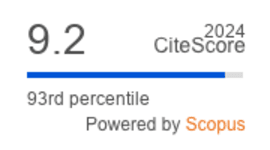Genomic and Resistome Analyses of Elizabethkingia anophelis Strain B2D isolated from Dental Plaque of Patient
DOI:
https://doi.org/10.36877/pmmb.a0000440Abstract
In this study, strain B2D isolated from a dental plaque sample of a human patient was studied for its general characteristics, taxonomic identification, genome features, and resistome profile. The bacterium exhibited antibiotic resistance to all beta-lactam antibiotics, nitrofuran, and sulfonamides, with high minimum inhibitory concentrations. It was only sensitive to the fluoroquinolone ciprofloxacin and intermediately susceptible to aminoglycoside tobramycin. A preliminary identification through 16S rRNA gene sequences revealed that it shared the highest sequence identity with Elizabethkingia anophelis subsp. endophytica JM-87T (100%) and Elizabethkingia anophelis subsp. anophelis R26T (99.31%). The draft genome of strain B2D was approximately 3.9 Mbp with 50 contigs and 35.5% GC content. A 16S rRNA gene and core genes-based phylogenetic analyses revealed a close phylogenetic relationship between strain B2D and the other Elizabethkingia type strains. An above species level threshold average nucleotide identity value confirmed its taxonomic identity as Elizabethkingia anophelis. Furthermore, we conducted a resistome analysis of strain B2D and Elizabethkingia type strains, revealing the presence of widespread antibiotic resistance genes, including beta-lactamases and genes associated with cationic antiseptic resistance and glycopeptide resistance. Overall, the multidrug resistant profile of strain B2D as elucidated and confirmed through whole genome analysis indicated its potential as a reservoir of beta-lactamase genes. Moreover, its presence within dental plaque in the human oral cavity prompts speculation regarding its role as an opportunistic pathogen capable of causing infections, particularly in immunocompromised individuals.
Downloads
Published
How to Cite
Issue
Section
License
Copyright (c) 2024 Share Yuan Goh, Kah-Ooi Chua, Saad Ahmed Khan, Noor Hayaty Abu Kasim, Yvonne Jing Mei Liew, Yin Yin Lau, Kar-Wai Hong, Wai-Fong Yin, Hoi-Sen Yong, Chien-Yi Chang, Ko Chan

This work is licensed under a Creative Commons Attribution-NonCommercial 4.0 International License.
Author(s) shall retain the copyright of their work and grant the Journal/Publisher right for the first publication with the work simultaneously licensed under:
Creative Commons Attribution-NonCommercial 4.0 International (CC BY-NC 4.0). This license allows for the copying, distribution and transmission of the work, provided the correct attribution of the original creator is stated. Adaptation and remixing are also permitted.

This broad license intends to facilitate free access to, as well as the unrestricted reuse of, original works of all types for non-commercial purposes.
The author(s) permits HH Publisher to publish this article that has not been submitted elsewhere.



.png)

.jpg)
